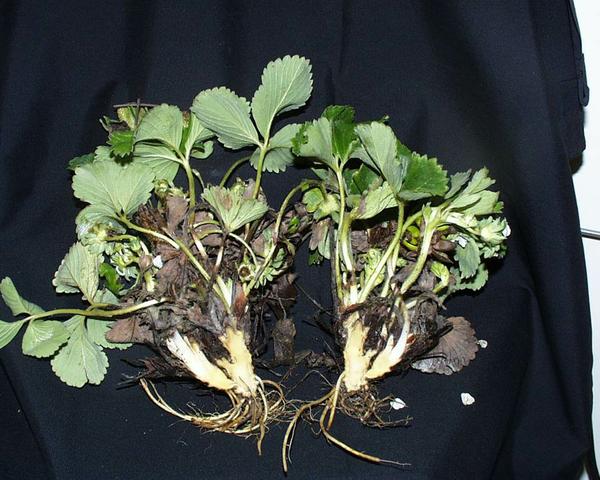Introduction
Botrytis crown rot occurs sporadically in annual production systems. The disease occurs in early to late winter or into the early spring under cool wet conditions. The disease is favored in the winter if blooms are frost killed; if excess plant growth occurs or plants are at a high density; or if winter-killed tissue is colonized by the pathogen. Certain cultivars such as ‘Sweet Charlie’ or other early blooming cultivars are more susceptible to the problem. Sometimes, growers can be caught by surprise if the disease develops under floating row covers used to promote growth or protect against cold events.
Symptoms and Signs
If warm spells occur during winter in plasticulture systems, early blooming cultivars may push out a flush of flowers. These inadvertently are winter-killed. Botrytis will colonize these damaged flowers and start to colonize down the flower stem (peduncle) and appear as a light brown rot. The pathogen continues to colonize down into the crown area which is usually very dense, in a rosette stage, and then the pathogen continues to colonize other stems and peduncles just above the crown. Affected leaves and tissue will turn brown (Figure SS-1) and a diagnostic feature is that the tissue will easily give way from the crown when pulled.
Alternatively, flowers may not develop (e.g. in cultivars such as ‘Chandler’ or ‘Camarosa’) but warm winters favor a highly dense plant growth habit. Under cool wet conditions Botrytis will colonize strawberry tissue just above the crown and leaves will begin to turn brown and die above the colonized region (Figure SS-2). The pathogen usually does not colonize the internal crown tissue (Figure SS-2) so once the weather is non-conducive to the pathogen or if management practices are put in place, the plant recovers with new flushes of growth; however, it may be set back in terms of early yield potential.
Disease Cycle
Botrytis can enter the field on transplant foliage. The fungus can live in the green tissue but be latent, or dormant, and not cause symptoms. Botrytis can affect many different crops and therefore weeds surrounding a field could be an important source of the pathogen. The pathogen can also produce dark hardened structures called sclerotia and these can persist in soils for years. Based on North Carolina research, it appears most infections occur from initial inoculum on leaf and crown tissue moving with transplants. In the case of symptomless leaf infections, as the infected strawberry leaf begins to die, the pathogen goes into an active stage, colonizing the leaf and obtaining its nutrients from the dead tissue. Spores then form and, once environmental conditions are appropriate (between 65-75°F [18-24°C] and with damp or rainy weather), they are dispersed by water splash and/or wind onto newly emerging leaves or blossoms. Botrytis crown rot is worse in years when early bloom occurs and this bloom is winter-killed. The pathogen colonizes the flower and then grows down into the crown tissue. Alternatively, the pathogen may colonize dead and dying tissue in the lower canopy and upper crown area and begin to macerate surrounding healthy tissue. In many cases, abundant sporulation is present (Figure SS-1) and this may result in further disease spread.
Management
Cultural
1. Plant Growth and Variety Selection
B. cinerea is commonly associated with transplant leaves and two years of research has demonstrated that there are no differences due to plant source or variety. Currently, it is not possible to obtain disease free plants and this should not be a burden on nursery growers. Plants that tend to bloom early are more susceptible (e.g. Sweet Charlie). Therefore, wise use of row covers to optimize plant growth and cold protection should also include avoidance of early bloom development or growth of plants that are too dense.
2. Monitor
Excess nitrogen will result in plants that are too dense and more susceptible to Botrytis. IF early bloom occurs, monitor for Botrytis colonization of the flowers and flower stems. These can be hand removed or a fungicide should be applied.
Chemical Control
Systemic fungicides are the most effective management tool and are best applied when Botrytis crown rot symptoms first appear or when many flowers are winter-killed. In general, we recommend a Rovral application since growers are allowed one application per season before bloom. This product has local systemic activity, is highly efficacious against Botrytis, and there is a low level of resistance to this product in the Southeast region. Switch also provides good control but it is best to save Switch and other Botryticides for bloom and fruit development sprays to manage gray mold of the fruit. Current fungicide recommendations are available in the Strawberry IPM Guide.
Publication date: July 24, 2014
Reviewed/Revised: July 26, 2024
There is an alternate Spanish language version of this document here: Moho gris de la corona de fresa
N.C. Cooperative Extension prohibits discrimination and harassment regardless of age, color, disability, family and marital status, gender identity, national origin, political beliefs, race, religion, sex (including pregnancy), sexual orientation and veteran status.


